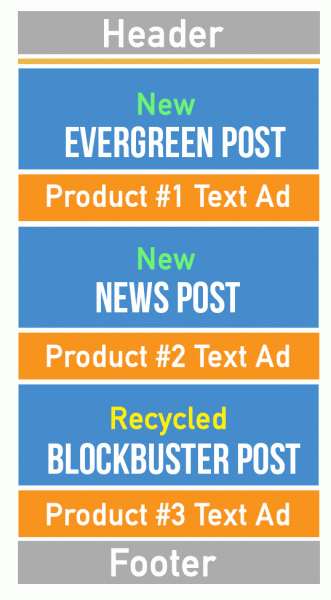
Typically we find that content falls into three buckets: news, evergreen, and blockbuster. Most Mequoda partners publish these three content types daily because each type serves a different purpose.
News content keeps your readers up to date on current events in your industry, and also fares well in social media.
Evergreen content allows you to create content that can be well-optimized for search and will be relevant for years.
And blockbuster content is the result of successful evergreen posts that rise to the top of search engines and drive a lot of traffic every month. We republish blockbuster posts regularly to update them, re-promote them in social, and keep them at the top of search engines.
[text_ad]
Creating news content

News content development is the process of driving traffic to your website through the use of breaking news that happens in your industry. Publishers and brands often use newsjacking as a way to create content, but need to find true alignment between the news and their industry to reap the benefits.
Here at Mequoda, we’re advocates for newsjacking, but only if you’re able to add value to the content that’s being shared.
What equates to added value in newsjacking?
First, add your response to the breaking news.
Then report their news and talk about how it applies to your audience. Pull in quotes, but also write a significant amount of original content for each piece too, resulting in 500+ words worth of content.
Next, make the content valuable to you in the long term. Because in the short term, its time as a news story is going to run out. Connect the story with more of your content by linking to at least three other articles on your site within the piece. Take the reader on a journey of the topic, far beyond the original news piece, and guide them through hyperlinks to related content. Make it easy to edit so that if it ended up driving traffic a few years down the road, you can update it.
Finally, look for a keyword that you can optimize the newsjacked piece for. This way, once the media storm has died down, you can still generate traffic through the article you’ve written with the help of good search engine optimization. In these cases, you may use proper nouns in keywords. If, over time, they turn into blockbuster posts, you may even go back in and update them if the title can work as evergreen content.
Creating evergreen content

The term evergreen is quite literal when it comes to botany, when it’s referring to any plant that stays green all year long, in any climate. Forever. It’s ever green.
Conifers, like pine trees, are evergreen. No matter whether it’s snowing, or if you’re in the middle of a four year drought, the needles on a pine tree stay green. Most trees in the rainforest are considered evergreen trees too, because even though they shed leaves, they do it slowly, and the tree is always full of new growth in its place.
On the other hand, Deciduous trees are not evergreen because they shed their leaves when it gets cold and look different depending on the time of year. At some points, they have no leaves, other times they have green leaves, and on other occasions they might have red, orange, or yellow leaves.
Evergreen content is no different than a conifer. It doesn’t expire. You could write it today and promote it in five years, and the content would rarely need to be updated.
Deciduous content, like news content or articles with headlines that ride the coattails of recent news events, known as newsjacking, do expire. Depending on the day of the year, or the season, the content isn’t relevant and may very well be incorrect.
Plenty of publishers do both, and they do it well. We have publishers with evergreen topics, like food and gardening, who can easily create evergreen content, and make exceptions for the occasional deciduous post for the sake of virality. We also have plenty of news publishers who create evergreen content.
Recycling blockbuster content

If you were to quickly search the internet for a definition of “blockbuster,” you’d see that it’s something of great power.
This is exactly why we put “blockbuster” before the name of all our best posts. They have great power. They drive a lot of traffic to your site and will do it consistently. They will continue to be your best traffic drivers because they are evergreen as well, and probably the best at converting visitors into registered users, especially when you’ve adopted 3C Zone Architecture.
You’ve probably heard us talk about blockbuster posts before if you’re familiar with the content we publish at Mequoda Daily. This is a favorite topic of ours because we understand the importance of these posts and we want you to, as well.
Our goal at Mequoda, and for our clients, is to create blockbuster posts every day. So every time we write an article, we are practicing the art of creating blockbuster posts. They don’t all win, but a percentage of them do. And they drive traffic for years. And that traffic converts into email subscribers for years, who convert into buyers for years. It’s only logical – optimize your content for search.
An official blockbuster post is a post that is already succeeding in organic search. A single blockbuster post may be generating tens of thousands of unique visitors per month. Knowing what these posts are, and carefully updating them regularly so they continue to send you that much traffic, is key.
Blockbuster posts aren’t set-it-and-forget-it posts. They will require upkeep just like anything else. This is especially true if your blockbuster post is on a keyword that has a lot of competition. If you currently have blockbuster posts in your content arsenal and you’ve witnessed them fall in search engine ranking, our article “How to Update a Blockbuster Post and Save it from Google Damnation” provides tips on getting your blockbuster to move back up in rank.
How to publish these three types of content daily via email

Most Mequoda publishing partners send out a daily email newsletter. We call it the email stack, because it kind of looks like a club sandwich (see to the right). When publishing all three types of content, we suggest formatting your email newsletter like so. If you’re in more of a news-worthy industry, the stacks can be arranged so that the news post comes first.
If you don’t have any blockbusters yet, or very few, we recommend two evergreen posts until you’ve developed a list of 100 blockbuster posts that you can rotate through on a bi-annual or annual basis.
In between each editorial snippet, we also place a text ad, either from a sponsor, or for a featured product. One Mequoda publisher who made the switch from a two-column email template to a one-column mobile-first design has seen a RPM increase of 3.6x.
And click rates increase too. At Mequoda we’ve seen click rates increase by 27% since switching to a mobile-first design. Clicks to our most important ad went up 250%.
Since mobile-first design is easier to read and digest, more of the content, including your ads, get seen.
How to promote these three types of content in social
By now you know we’re all about the 12x12x12 method. Write twelve unique Tweets for each article. Schedule them for 12 days. Then schedule them for 12 months. For an entire year, your article will be promoted and you only have to do it once.
For Facebook and LinkedIn, write two unique posts. Schedule on the first day, then again in six months.
Since news posts have content that expire, we will typically do a 6x6x6 — 6 unique tweets scheduled for the first 6 days, and then once a week for the next 6 weeks. You could reduce even more if it’s especially timely. On Facebook and Linkedin we usually schedule just the first day for news posts. Here’s a more detailed look at an effective SMO strategy for your daily content, including promotional posts.
How are you currently creating content for your Portal, and at what volume? What works for you?


